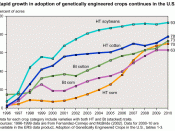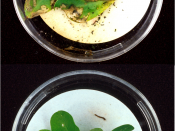Since the first studies and manipulations of Mendel and his laws of "heredity", a good deal of research has been done on what every living organism is composed of. In 1951, three scientists discovered the key factor of this research: deoxyribonucleic acids, or DNA. This is the material which carries the hereditary instructions (the "blueprint") which determines the formation of all living organisms. Genes, the organizers of inheritance, are composed of DNA. Several years ago this science revealed the magnitude of its scope with the discovery of the whole universal genetic code. That is to say the whole list of the genes that can compose an organism. Universal means that a same gene can be found in different species. On the basis of these discoveries scientists started playing with genes. Adding one here, taking another one off there and thus creating new species. But now the machine has started, some claim it is high time back-pedalling.
But the promises of a better future it gives rise to are worth reflection.
In the field of genetic engineering, our first concern and debate is about genetically modified food. Although genetic engineering has been going on for over 30 years, scientists have only recently begun to master to art of genetic engineering and commonly using them in animals and crops. Since 1996, millions of acres of farmland have been planted with genetically engineered crops. It is a technology that combines genes from totally dissimilar species in combinations that are not achievable using conventional breeding methods. Genes from an animal, say, a fish, can be put into a plant, a strawberry for instance, to improve the quality of strawberry plants. The fish gene is supposed to make the strawberries more resistant to frost by causing the strawberry plant to compose a form of antifreeze...


